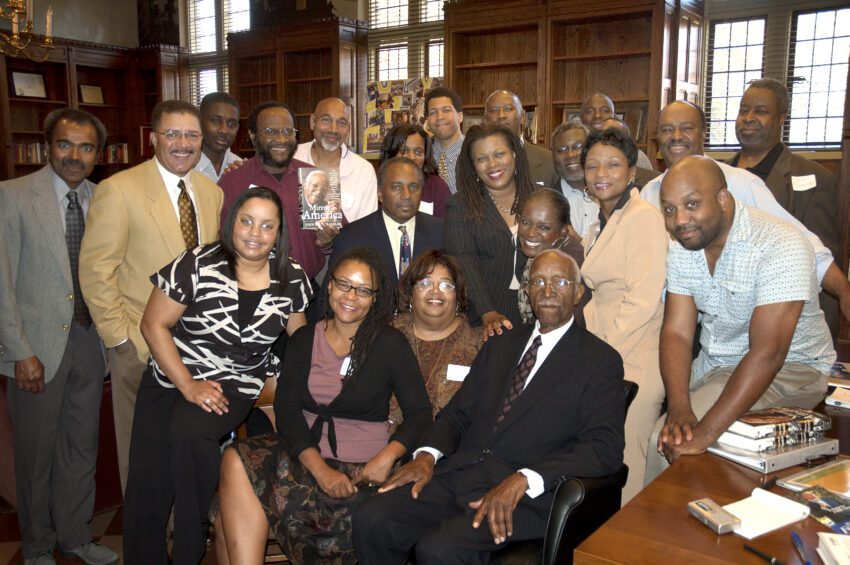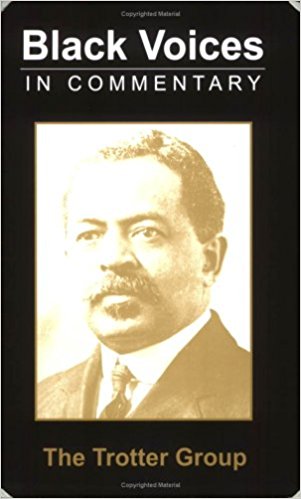
The Trotter Group at Stanford University, Nov. 13-16, 1994.
Hosted by the John S. Knight Journalism Fellowships program
First row: Betty Baye, Lorraine Key Montre, Brenda Payton, Don Williamson, Peggy Peterman, Nichele Hoskins.
Second row: Richard Prince, Sheryl McCarthy, Adrienne Washington. Third row: Kevin B Blackistone, DeWayne Wickham, Loretta Green, Lisa Baird, Fourth row: Norman Lockman, Vernon Jarrett, Larry Whiteside, Derrick Jackson, Sherman N. Miller. Fifth row: Wayne Dawkins, Lewis Diuguid, Gregory Freeman, Les Payne.
Developing the Black Viewpoint
By Les Payne
Les Payne, columnist and assistant managing editor at Newsday, made an opening statement, “the call,” as a group of black columnists began their meeting under the sponsorship of the Nieman Foundation at Harvard University on Dec. 8, 1992.
As DeWayne Wickham mentioned in our letter inviting you to this retreat for black columnists here at Harvard University, it was H.L. Mencken who in 1929, wrote:

“The Negro leader of today is not free. He must look to white men for his very existence, and in consequence he had to waste a lot of his energy trying to think white. What the Negroes need is leaders who can and will think black.”
Who is Mencken, you might ask, to offer such advice to black columnists? Wasn’t he a racist and anti-Semitic? He may well have been both, without question. But he was also one of the most influential newspaper columnists this republic has produced.
The word that best describes the columnist Mencken is iconoclast. The man made a career of using his column in The Baltimore Sun to break icons, trying single-handedly to overthrow the deeply held traditional American notions that were the residue of Puritanism. Chief among these practices were religious fundamentalism, demagoguery and Ku Kluxery. Mencken used his columns vigorously to attack them all.
As Voltaire in his writing set out to destroy Christianity, Mencken swung his battle ax against Puritanism.
I suggest that those of us who may want to use our writing as a weapon against racism could learn a thing or two from Voltaire and Mencken. Fortunately, there are also other models closer to our circumstance, such as William Monroe Trotter, W.E.B. DuBois, David Walker, Martin Robinson Delany, Ida B. Wells, Zora Neale Hurston and a host of other modern black writers I’m sure we will mention during this retreat. (I hope that we will compile a recommended reading list before this retreat is over.)

When the poet John Ciardi was accused of stealing from other writers, he responded:
“All artists and writers steal, the trick is to case the right joints.”
We want, among other things, at this retreat, to explore the right joints for black columnists to case. I’m not suggesting that you plagiarize from anyone. Upon hearing that a black writer once plagiarized Carl Rowan, one editor asked: “Why Carl Rowan?” Another said: “Who would notice?” Given his history with Malcolm X, Carl Rowan is perhaps not one of the joints black columnists should case.
During the Harlem Renaissance, writers such as Jean Toomer, James Weldon Johnson, Walter White, Zora Neale Hurston, Langston Hughes, George Schuyler — even W.E.B. Du Bois — praised H.L. Mencken’s influence upon black letters. All of these writers and many others were published in Mencken’s American Mercury magazine in the 1920s and ’30s when other white periodicals shunned them.
Mencken, incidentally, was the single greatest initial influence on the writing career of Richard Wright. There’s an interesting story about this in his autobiographical book, “Black Boy.”
After reading an attack on Mencken in the Memphis Commercial Appeal, 18-year old Wright borrowed a white man’s library card, since blacks were not allowed “to patronize (library) shelves any more than they were the parks and playgrounds of the city.” To check out Mencken’s “A Book of Prefaces,” Wright forged the card-owner’s name to the following note:
“Dear Madam:
“Will you please let this nigger boy have some books by H.L. Mencken?”
That night Wright’s caper was rewarded:
“I opened A Book of Prefaces and began to read. I was jarred and shocked by the style, the clear, clean, sweeping sentences. Why did he write like that? And how did one write like that? I pictured the man as a raging demon, slashing with his pen, consumed with hate, denouncing everything American, extolling everything European or German, laughing at the weaknesses of people, mocking God, authority. What was this? I stood up, trying to realize what reality lay behind the meaning of the words. He was using words as a weapon, using them as one would use a club. Could words be weapons? Well, yes, for here they were. Then, maybe, perhaps, I could use them as a weapon? No. It frightened me. I read on and what amazed me was not what he said, but how on earth anybody had the courage to say it.”

In relating Mencken’s influence on Richard Wright, I want to make it clear that I am not recommending Mencken or other white writers and columnists as role models. As young Wright discovered, while denouncing Americans’ hypocrisy, Mencken was “extolling everything European or German.”
We can learn technique and approaches from white artists but authenticity in this racist society demands that we develop our own perspective and wage our campaign ourselves. Since our forebears crossed the Atlantic in slave ships, we as black columnists should not write as if they crossed on the Mayflower. That’s one reason we’ve organized this retreat. The adaptive problem of black columnists is similar to how black parents must protect their children from European-dominated public elementary school: They can teach our children how to read, we must teach them what to read.
In Wright’s case, he may well have fallen too much under the influence of Mencken, ending up, as his mentor warned other blacks in 1929, thinking white. In one of her critiques of Wright, Margaret Walker suggests this very problem in Wright’s work:
“All the forces influencing Wright were forces of the white world. He seems to have been shaped very little by black people. As a matter of fact black people were never his ideals. He championed the cause of the black man but he never idealized or glorified him (this latter is a damning, yet fair criticism.) His black men characters were always seen as victims of society, demeaned and destroyed and corrupted to animal status. . . . Every positive force he recognized in his life stemmed from white forces. Intellectually his teachers and master-models were all white. . . his favorite authors were all white (Mencken’s influence and taste-setting). I cannot think of a single black author during the ’30s whom he admired to the point that he considered him equal of any white writer. He had no great respect for the literary achievements of black people, not even Langston Hughes or W.E.B. Du Bois.”
This is instructive to us as columnists, I think we have to be mindful of being too much influenced by white columnists, editors and even white readers. One of the key problems, of course,is the dual audience.
Many, if not all, of us write for a predominantly white readership. As such, we write for a dominant society that has a different set of assumptions, a different orientation, and are likely to draw different conclusions from the same set of facts. In the 1989 election in New York, for instance, liberal white columnists like Jack Newfield were bragging about how white New Yorkers had matured to the point where 30 percent of them would vote for David Dinkins, an experienced black Democratic candidate, for mayor.
Black commentators looking at the same results pointed out that in a city where Democrats outnumbered Republicans 8 to 1, 70 percent of the white voters cast their ballot for an inexperienced white Republican, Rudolph Guliani, who had never held an elected office.
As black columnists we need to construct, define, analyze and most of all dedicate our voices, mixed and diverse as they are, as instruments for change, racial fairness and empowerment.
A.J. Liebling said that, in America, no one enjoys freedom of the press except those who own one.
Within that construct, columnists may well be the most powerful writers in the craft. Consider the influence of such white columnists as:
Mencken, A.J. Liebling, Walter Lippmann, James Reston, William F. Buckley, George Will, Evans and Novak, Art Buchwald, Russell Baker, Mary McGrory, Murray Kempton, Jimmy Breslin, Tom Wicker, Ellen Goodman, Anna Quindlen, Pat Buchanan, Andy Rooney, Ann Landers, Erma Bombeck, William Safire, David Broder, Dave Anderson, Red Smith, Charles Krautharnmer, Dave Barry, Jim Hoagland, Mike Royko, Anthony Lewis, Flora Lewis, Richard Cohen.
Where are the black counterparts to these well-known, influential and rich columnists? I think we need to begin making sure that we field a counterforce to the white viewpoint in the media not just this year, but for generations to come.
During the next two days, we need to analyze all aspects of column writing with an eye toward rapidly developing and empowering the black viewpoint in the media. We want to act so that once again we won’t have to simply react. As the old Southern ditty goes: “You can’t beat a horse with no horse.” You can’t counter powerful white columnists without powerful black columnists.
At this retreat, we want to explore ways to get moving.


Also Online:
- Les Payne: The Trotter Group: Opening Statement
- DeWayne Wickham: ‘We Wanted to Do What We Could to Insure That the Voices of Black Columnists Would Speak the Loudest . . . ‘
- Derrick Z. Jackson: William Monroe Trotter Was Perhaps the Most ‘Rude’ African American Journalist This Nation Has Produced
- A Session With President Obama, 2010
- Shorenstein Center, John F. Kennedy School, Harvard University: Black newspaper columnists look at the next [four] years (Nov. 9, 2004) Video
Support Journal-isms
When you shop @AmazonSmile, Amazon will make a donation to Journal-Isms Inc. https://t.co/OFkE3Gu0eK
— Richard Prince (@princeeditor) March 16, 2018
Facebook users: “Like” “Richard Prince’s Journal-isms” on Facebook.
Follow Richard Prince on Twitter @princeeditor
To be notified of new columns, contact journal-isms-subscribe@yahoogroups.com and tell us who you are.
View previous columns (after Feb. 13, 2016).
- Journalist Richard Prince w/Joe Madison (Sirius XM, April 18, 2018) (podcast)
- Richard Prince (journalist) (Wikipedia entry)
- February 2018 Podcast: Richard “Dick” Prince on the need for newsroom diversity (Gabriel Greschler, Student Press Law Center, Feb. 26, 2018)
- Diversity’s Greatest Hits, 2017 — Where Will They Take Us in the Year Ahead?
- Book Notes: Best Sellers, Uncovered Treasures, Overlooked History (Dec. 19, 2017)
- An advocate for diversity in the media is still pressing for representation, (Courtland Milloy, Washington Post, Nov. 28, 2017)
- Morgan Global Journalism Review: Journal-isms Journeys On (Aug. 31, 2017)
- Diversity’s Greatest Hits, 2016

